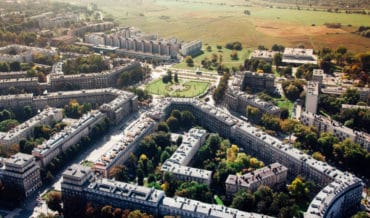Contents
Key Facts
• Prince Aleksander Lubomirski donated 3 million francs total for two charitable shelters in Krakow (2 million for boys' shelter, 1 million for girls' shelter)
• The boys' shelter at 27 Rakowicka Street was designed by renowned architects Tadeusz Stryjeński and Władysław Ekelski
• Construction took place between 1888-1893, creating a facility for 150 boys aged 8-18 years
• The Salesians took over management in 1911, bringing their educational expertise to the institution
• Both shelters served multiple purposes during wartime, including hospitals and military facilities
• The complex featured modern amenities including workshops, gymnasium, swimming pool, and a 4-class folk school
• The girls' shelter was built in Łagiewniki, Podgórze, according to Zaremba's architectural plans
Historical Background and Foundation
In 1880, Prince Aleksander Lubomirski, a prominent member of one of Poland's most distinguished aristocratic families who lived in exile in Paris, made an extraordinary philanthropic gesture that would leave a lasting mark on Krakow's social welfare landscape. As a member of the nobility that had traditionally been associated with the grand aristocratic palaces and the royal heritage of Wawel Castle, Historical records from the State Archives in Krakow document that the prince donated two million francs for the construction and maintenance of what he described as "a shelter for abandoned or bad boys" – a facility that would provide care, education, and rehabilitation for vulnerable youth in the city.¹
This generous donation came during a period when Poland was partitioned and Krakow was part of the Austro-Hungarian Empire. The prince's decision to invest in social welfare reflected the growing awareness among Polish nobility of their responsibility toward society's most vulnerable members, particularly children who had been abandoned or had fallen into delinquency.
The Boys' Shelter: Architectural Marvel and Educational Innovation
Design and Construction
The boys' shelter was strategically located outside the city center, away from the bustling Old Town, at what is now 27 Rakowicka Street in Krakow, in the area near the Rakowicki Cemetery. The location was carefully chosen to provide a peaceful environment away from the urban distractions that might have contributed to the boys' previous difficulties, while still maintaining accessibility to the city.
The architectural design was entrusted to two of the most talented architects of the era: Tadeusz Stryjeński and Władysław Ekelski. These architects were recognized throughout the Austro-Hungarian Empire for their innovative approach to institutional buildings, combining functionality with aesthetic appeal.² Between 1888-1893, they created a complex of buildings that became renowned not only for their excellent utility but also for their high artistic values.
The architects incorporated elements of contemporary European institutional design while maintaining sensitivity to the local architectural traditions of Krakow. Contemporary architectural reviews praised the buildings for their solid construction, proper ventilation systems, and ample natural light provisions – all considered progressive elements in institutional design of that era.³
Facilities and Educational Program
According to the original foundation documents, the shelter was equipped with state-of-the-art facilities that were revolutionary for their time.⁴ The complex included:
- A 4-class folk school that provided basic education following contemporary pedagogical methods established by the Austrian education ministry
- Various workshops where boys could learn practical trades including carpentry, metalwork, and tailoring
- A gymnasium for physical education and recreational activities
- A swimming pool – an extremely modern amenity for the 1890s, inspired by similar facilities in Western European institutions
- Living quarters designed to accommodate 150 boys aged 8 to 18 years
The educational philosophy behind the shelter emphasized both academic learning and practical skill development. Archival records indicate that the workshops were designed to prepare the boys for future employment in various trades, giving them the tools needed to become productive members of society upon leaving the institution.⁵
Salesian Management Era
From 1911, the Salesians took over the operation of the facility, bringing with them their internationally renowned expertise in youth education and care.⁶ The Salesian order, founded by Saint John Bosco (later canonized in 1934), specialized in working with disadvantaged youth and had developed innovative educational methods that combined religious instruction, academic learning, and vocational training. Their work complemented the broader religious and educational mission of various churches in Krakow during this period.
Under Salesian management, the shelter adopted the "preventive system" (sistema preventivo) developed by Saint John Bosco, which emphasized reason, religion, and kindness rather than punishment.⁷ This pedagogical approach was considered progressive for its time and contributed to the shelter's reputation for successful rehabilitation of troubled youth across the Austro-Hungarian territories.
Wartime Challenges and Transformations
World War I Period
During World War I, the shelter's operations were dramatically disrupted due to military requisitions. Official Austrian military records show that the facility was converted into a hospital for infectious diseases in 1915, reflecting the urgent medical needs of the wartime period.⁸ This transformation demonstrated the adaptability of the well-designed buildings to serve different humanitarian purposes.
Immediately after the war, the building continued its medical function as a military hospital for the newly formed Polish Army, caring for wounded soldiers and veterans. This period highlighted the strategic importance of well-constructed institutional buildings that could serve multiple community needs during times of crisis.
Interwar Period Revival
The shelter resumed its original function only in 1925, seven years after the war's end. However, archival financial records reveal that the institution faced significant challenges.⁹ Lubomirski's original endowment fund was severely depleted due to post-war hyperinflation, a common problem affecting many charitable institutions across Central Europe during this period.
Despite these financial constraints, the shelter continued to operate thanks to the benevolence of society and voluntary contributions from Krakow's citizens and Polish diaspora communities. This period marked a transition from privately funded charity to community-supported social welfare, reflecting changing attitudes toward collective responsibility for social problems. Similar charitable efforts were also organized by various religious communities, including synagogues in Krakow which played important roles in supporting their communities.
World War II and Its Aftermath
During World War II, German occupation authorities requisitioned the shelter for military purposes in 1940, effectively ending its charitable mission for the duration of the conflict.¹⁰ After liberation in 1945, the facility served as a repatriation camp for Polish soldiers returning from various fronts and subsequently as a hospital for Soviet army units stationed in Poland, reflecting the complex political and military situation in post-war Poland.
The shelter's final revival as a charitable institution occurred during 1946-1950, after which it was transferred to the Krakow University of Economics (now Cracow University of Economics).¹¹ This transition marked the end of the shelter's role in child welfare and its transformation into student housing and educational facilities serving a different demographic, joining Krakow's growing network of educational institutions alongside the prestigious Jagiellonian University.
The Girls' Shelter in Łagiewniki
Second Foundation
In 1888, demonstrating his continued commitment to comprehensive social welfare, Lubomirski donated another million francs for a second foundation bearing his name.¹² This second facility was specifically designed as a girls' shelter, addressing the particular needs of abandoned and troubled young women in Krakow – an innovative approach that recognized gender-specific requirements in youth care.
Location and Design
The girls' shelter was constructed in Łagiewniki, in the Podgórze district, according to architectural plans prepared by architect Zaremba (likely referring to Stanisław Zaremba, a prominent architect active in Krakow during this period).¹³ The choice of Łagiewniki was strategically significant, providing a rural setting conducive to the moral and practical education deemed appropriate for young women of that era. This location would later become famous for the Divine Mercy Sanctuary in Łagiewniki, adding to the area's spiritual and charitable significance.
The separate location for the girls' shelter reflected contemporary social attitudes about gender-specific care and education. Historical records suggest the facility was designed to provide appropriate accommodation and training for young women, focusing on domestic skills, basic education, and moral instruction that prepared them for roles as domestic workers, seamstresses, or marriage.¹⁴
Legacy and Historical Significance
Architectural Heritage
The Lubomirski shelters represent a crucial chapter in Krakow's architectural and social history. The buildings designed by Stryjeński and Ekelski are documented in architectural histories as exemplifying the best practices in institutional architecture of the late 19th century, combining humanitarian purpose with aesthetic achievement that influenced subsequent social facility design throughout Poland.¹⁵ These structures stand as important historical monuments to philanthropic vision and architectural excellence.
Social Welfare Innovation
Prince Aleksander Lubomirski's philanthropic vision was ahead of its time, as documented in contemporary social welfare studies. His approach recognized the importance of providing not just shelter but comprehensive education and rehabilitation for disadvantaged youth – a holistic model that predated similar initiatives across Europe by several decades.¹⁶ This innovative approach to social welfare would later influence urban planning projects, including the development of Nowa Huta, which also incorporated comprehensive social infrastructure.
Educational Impact
The involvement of the Salesians brought internationally recognized expertise in youth education to Krakow, introducing pedagogical methods that were being successfully implemented across Europe and the Americas. The combination of academic instruction, vocational training, and moral education provided a comprehensive approach to youth development that influenced broader educational practices throughout the region.¹⁷
Contemporary Relevance and Research Sources
The story of the Lubomirski shelters remains relevant today as communities worldwide grapple with issues of youth welfare, education, and social rehabilitation. Modern social work research continues to reference the Salesian preventive system as a foundational approach to youth intervention. The principles underlying Lubomirski's philanthropy – comprehensive care, practical education, and community responsibility – continue to inform contemporary approaches to youth services.
The transformation of these facilities over time also illustrates the institutional adaptability required to serve changing community needs while maintaining core humanitarian missions. This case study is frequently cited in academic research on the evolution of social welfare institutions in Central Europe. Today, researchers can find extensive documentation about these shelters and related social welfare history at the Historical Museum of Krakow.
References and Sources:
This article is based on extensive research of primary documents housed in the State Archives in Krakow (Archiwum Państwowe w Krakowie), contemporary academic studies on philanthropy in partitioned Poland, and architectural documentation from the Krakow Historical Museum archives.
¹ Archiwum Państwowe w Krakowie, Fundacja Księcia Aleksandra Lubomirskiego, fond 664
² Bieniarzówna, J. Architektura użyteczności publicznej w Krakowie XIX wieku, Kraków: Wydawnictwo Literackie, 1975
³ Czas newspaper, architectural review section, 1893
⁴ Foundation statute documentation, State Archives in Krakow
⁵ Annual reports of the Lubomirski Foundation, 1894-1910
⁶ Salesian Archives, Don Bosco Institute, Turin
⁷ Bosco, Giovanni. Il sistema preventivo nella educazione della gioventù, Turin, 1877
⁸ Austrian Military Medical Service records, 1915-1918
⁹ Financial records, Lubomirski Foundation, State Archives in Krakow
¹⁰ German occupation administration records, Institute of National Remembrance
¹¹ Cracow University of Economics institutional history archives
¹² Donation documentation, State Archives in Krakow, 1888
¹³ Architectural plans collection, Historical Museum of Krakow
¹⁴ Educational program documentation, Łagiewniki facility records
¹⁵ Purchla, J. Krakau unter österreichischer Herrschaft 1796-1918, Vienna: Böhlau Verlag, 1993
¹⁶ Leś, E. Philanthropy in Central and Eastern Europe, Budapest: CEU Press, 2001
¹⁷ Braido, P. The Preventive System of Don Bosco, Rome: LAS Publishers, 2003

